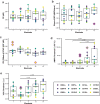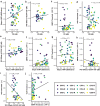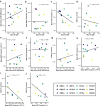Assessing the Relationship Between Pitch Perception and Neural Health in Cochlear Implant Users
- PMID: 36329369
- PMCID: PMC9789247
- DOI: 10.1007/s10162-022-00876-w
Assessing the Relationship Between Pitch Perception and Neural Health in Cochlear Implant Users
Abstract
Various neural health estimates have been shown to indicate the density of spiral ganglion neurons in animal and modeling studies of cochlear implants (CIs). However, when applied to human CI users, these neural health estimates based on psychophysical and electrophysiological measures are not consistently correlated with each other or with the speech recognition performance. This study investigated whether the neural health estimates have stronger correlations with the temporal and place pitch sensitivity than with the speech recognition performance. On five electrodes in 12 tested ears of eight adult CI users, polarity effect (PE), multipulse integration (MPI), and interphase gap (IPG) effect on the amplitude growth function (AGF) of electrically evoked compound action potential (ECAP) were measured to estimate neural health, while thresholds of amplitude modulation frequency ranking (AMFR) and virtual channel ranking (VCR) were measured to indicate temporal and place pitch sensitivity. AzBio sentence recognition in noise was measured using the clinical CI processor for each ear. The results showed significantly poorer AMFR and VCR thresholds on the basal electrodes than on the apical and middle electrodes. Across ears and electrodes, only the IPG offset effect on ECAP AGF had a nearly significant negative correlation with the VCR threshold after removing the outliers. No significant across-ear correlations were found between the mean neural health estimates, mean pitch-ranking thresholds, and AzBio sentence recognition score. This study suggests that the central axon demyelination reflected by the IPG offset effect may be important for the place pitch sensitivity of CI users and that the IPG offset effect may be used to predict the perceptual resolution of virtual channels for CI programming.
Keywords: Cochlear implant; Neural health; Pitch ranking; Speech recognition.
© 2022. The Author(s) under exclusive licence to Association for Research in Otolaryngology.
Conflict of interest statement
The authors declare no competing interests.
Figures



Similar articles
-
Using the electrically-evoked compound action potential (ECAP) interphase gap effect to select electrode stimulation sites in cochlear implant users.Hear Res. 2021 Jul;406:108257. doi: 10.1016/j.heares.2021.108257. Epub 2021 Apr 28. Hear Res. 2021. PMID: 34020316 Free PMC article.
-
Across-site patterns of electrically evoked compound action potential amplitude-growth functions in multichannel cochlear implant recipients and the effects of the interphase gap.Hear Res. 2016 Nov;341:50-65. doi: 10.1016/j.heares.2016.08.002. Epub 2016 Aug 10. Hear Res. 2016. PMID: 27521841 Free PMC article.
-
Effects of pulse shape on pitch sensitivity of cochlear implant users.Hear Res. 2024 Sep 1;450:109075. doi: 10.1016/j.heares.2024.109075. Epub 2024 Jul 3. Hear Res. 2024. PMID: 38986164
-
Electrophysiological Estimates of the Electrode-Neuron Interface Differ Between Younger and Older Listeners With Cochlear Implants.Ear Hear. 2020 Jul/Aug;41(4):948-960. doi: 10.1097/AUD.0000000000000827. Ear Hear. 2020. PMID: 32032228 Free PMC article.
-
Peripheral Neural Synchrony in Postlingually Deafened Adult Cochlear Implant Users.Ear Hear. 2024 Sep-Oct 01;45(5):1125-1137. doi: 10.1097/AUD.0000000000001502. Epub 2024 Mar 20. Ear Hear. 2024. PMID: 38503720 Free PMC article.
Cited by
-
Editorial: Views on JARO 2023.J Assoc Res Otolaryngol. 2024 Feb;25(1):1-3. doi: 10.1007/s10162-024-00931-8. J Assoc Res Otolaryngol. 2024. PMID: 38345701 Free PMC article. No abstract available.
-
Electrically evoked compound action potential polarity sensitivity, refractory-recovery, and behavioral multi-pulse integration as potential indices of neural health in cochlear-implant recipients.Hear Res. 2023 Jun;433:108764. doi: 10.1016/j.heares.2023.108764. Epub 2023 Apr 11. Hear Res. 2023. PMID: 37062161 Free PMC article. No abstract available.
-
A Prospective, Multicentre Case-Control Trial Examining Factors That Explain Variable Clinical Performance in Post Lingual Adult CI Recipients.Trends Hear. 2025 Jan-Dec;29:23312165251347138. doi: 10.1177/23312165251347138. Epub 2025 Jun 27. Trends Hear. 2025. PMID: 40576960 Free PMC article.
-
The relationship between channel interaction, electrode placement, and speech perception in adult cochlear implant users.J Acoust Soc Am. 2024 Dec 1;156(6):4289-4302. doi: 10.1121/10.0034603. J Acoust Soc Am. 2024. PMID: 39740049
References
-
- Blamey P, Artieres F, Başkent D, Bergeron F, Beynon A, Burke E, Dillier N, Dowell R, Fraysse B, Gallégo S, Govaerts PJ, Green K, Huber AM, Kleine-Punte A, Maat B, Marx M, Mawman D, Mosnier I, O’Connor AF, Lazard DS. Factors affecting auditory performance of postlinguistically deaf adults using cochlear implants: an update with 2251 patients. Audiol Neurotol. 2012;18(1):36–47. doi: 10.1159/000343189. - DOI - PubMed
Publication types
MeSH terms
LinkOut - more resources
Full Text Sources
Medical
Miscellaneous

